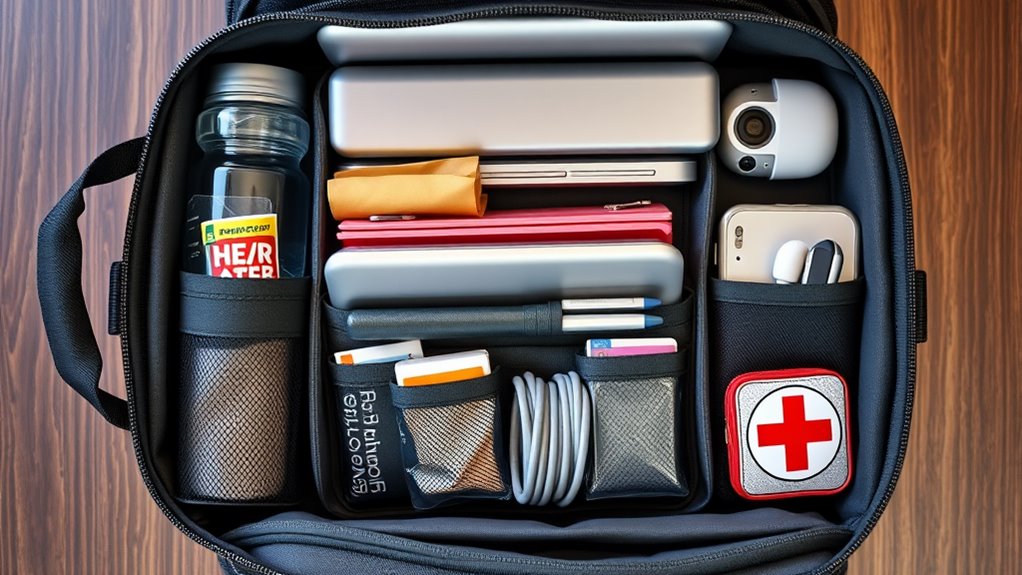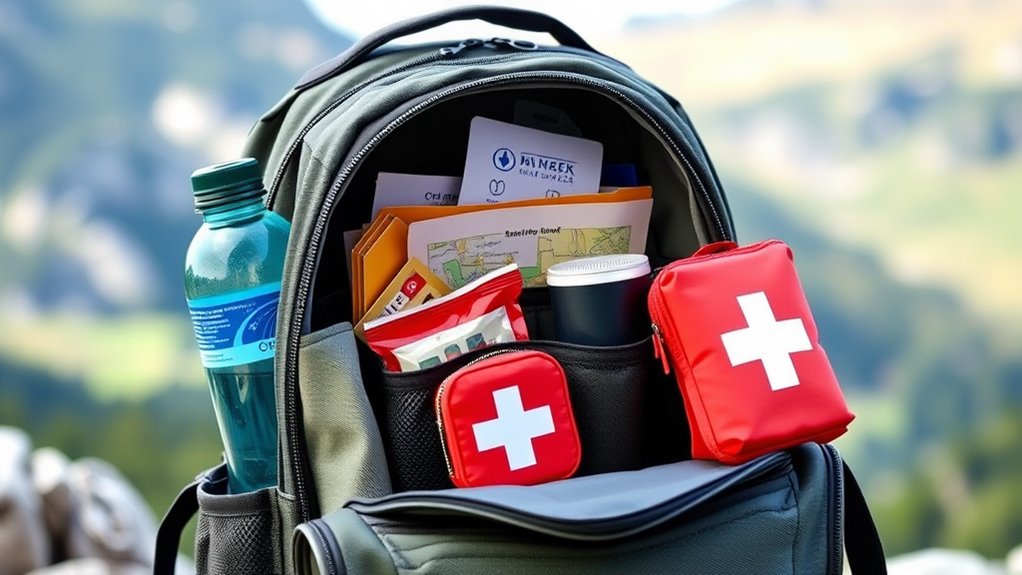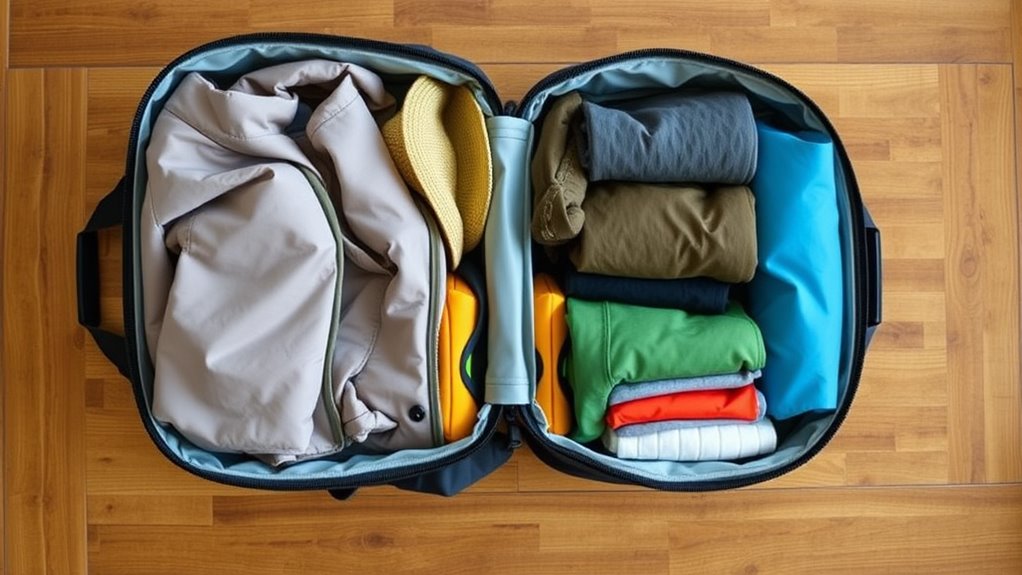Best Ways to Organize a Backpack for Efficient Packing
This post contains affiliate links. As an Amazon Associate, we earn from qualifying purchases.
To organize your backpack efficiently, start by cleaning it out completely. Sort and categorize your items like school supplies and materials by subject. Use compartments wisely—keep essentials and frequently used items at the front and in outer pockets. Balance the weight by placing heavy items close to your back. Finally, maintain a regular cleaning routine and adjust your packing depending on the season for best performance. There’s more to uncover about making your packing even smoother.
Key Takeaways
- Start with a clean backpack to eliminate debris and clutter, creating a fresh space for packing.
- Sort items by category and frequency of use, grouping school materials and supplies for easy access.
- Utilize compartments effectively by placing frequently used items in outer pockets and organizing supplies with smaller pouches.
- Distribute weight evenly by placing heavy items close to your back and maintaining a low center of gravity.
- Regularly maintain your backpack by emptying it weekly and reviewing contents to prevent overpacking and ensure essentials are included.
Start With a Clean and Empty Backpack
Before diving into your backpack organization, it’s essential to start with a clean and empty bag.
Begin by completely emptying your backpack, including all compartments, to remove any leftover debris. Shake it over a trashcan to dislodge crumbs and lint that may have accumulated inside.
If you’re using a new backpack, there’s no need to clean, but for a used one, getting rid of old items helps establish a clean slate for packing.
A clean backpack not only prevents clutter accumulation but also allows for better organization of essential items based on their usage frequency.
Starting with an empty and clean backpack sets the foundation for efficient packing, ultimately enhancing your overall packing process.
Sort and Categorize Your Items
As you begin to organize your backpack, sorting and categorizing your items can greatly streamline the packing process.
Start by emptying your backpack completely to create a fresh base. Then, sort your items into three main categories: essential school materials like textbooks and notebooks, school supplies such as pens and pencils, and other seasonal items like clothing or lunch boxes.
Discard anything that doesn’t fit these categories to keep only what’s necessary. For easy access, organize your school materials by subject, stacking binders and notebooks with spines facing outward.
Use small pouches for loose supplies like markers and erasers, preventing chaos and ensuring efficient packing. This method will make your backpack neat and functional.
Utilize Compartments and Pockets Effectively

To make the most of your backpack, focus on where you place your frequently used items for easy access.
Categorizing your gear by type not only keeps things organized but also helps you find what you need quickly.
Don’t forget to take advantage of external pockets for essentials like water bottles and maps while you’re on the go.
Prioritize Frequently Used Items
When you prioritize frequently used items in your backpack, you streamline your access during hikes or busy school days.
Keep essentials like snacks, water bottles, and sunscreen in outer pockets for quick access, so you don’t have to dig through your entire bag.
Organize school supplies by frequency of use; place daily essentials up front while less-used items can go deeper in the main compartment.
Use smaller compartments for pens and notebooks to prevent clutter, making retrieval easier when you need them.
Layer books and notebooks from the bottom up based on usage frequency, ensuring the most essential materials are readily available.
Consider color-coding binders and folders for quick identification, enhancing your overall organization.
Categorize Gear by Type
Organizing your backpack by categorizing gear not only enhances efficiency but also makes it easier to find what you need on the go.
Here are some tips to help you categorize gear effectively:
- Main Compartment: Store heavier items like cooking equipment and food near your back for balance.
- Outer Pockets: Keep frequently accessed items, such as snacks and water, in outer pockets for quick access.
- Packing Cubes: Use packing cubes or dry sacks to group similar items, like clothing or first aid supplies, for easy retrieval.
- Designated Pockets: Assign specific pockets for essential tools like a flashlight or multitool, ensuring they’re always easy to find.
Utilize External Pockets
Utilizing external pockets effectively can transform your backpacking experience by keeping essential items within easy reach. Use these pockets to store frequently accessed items like snacks, maps, and sunscreen, so you won’t need to dig through the main compartment.
The hip pockets are perfect for carrying water bottles, guaranteeing hydration is always accessible while maintaining balance. For emergencies, keep a first aid kit or headlamp in the upper external pockets for quick retrieval at night.
Side pockets can hold lightweight items like a jacket or rain gear, keeping your pack organized. Finally, designate a specific pocket for your phone or GPS to prevent loss and make sure they’re easily accessible during your hike.
Prioritize Accessibility for Frequently Used Items

To make your backpack more user-friendly, prioritize putting frequently used items in easily accessible locations. This way, you won’t have to dig through your entire pack when you need something quickly.
Here’s how to organize:
- Outer Pockets: Store snacks, sunscreen, and first aid supplies for easy access without unpacking.
- Top Compartment: Keep essential gear like a rain jacket or map, so you can grab it fast during a hike.
- Side Pockets: Place hydration sources, like water bottles, here to drink on the move.
- Small Pouch: Pack daily essentials like electronics and toiletries in an organizer for quick retrieval.
Balance Weight Distribution for Comfort
To hike comfortably, you need to position heavy gear close to your back and above your hips for better stability.
Make sure to balance the weight by keeping similar items together and distributing them evenly throughout your pack.
This way, you’ll maintain a low center of gravity and reduce strain on your shoulders as you move.
Position Heavy Gear Correctly
Packing heavy gear correctly is essential for a comfortable hiking experience. Proper weight distribution helps maintain your center of gravity, minimizing strain on your body.
Here are some tips for positioning heavy items in your backpack:
- Internal Frame Backpack: Place heavy gear against the back panel, above your iliac crest but below your shoulder blades for stability.
- Avoid the Top: Don’t pack heavy items at the top; this can disrupt balance and increase injury risk.
- External Frame Backpack: Position heavier items toward the top but still against the back panel for better weight management.
- Close to Your Body: Keep heavy gear close to prevent shifting the center of gravity backward, enhancing comfort and convenience on tough terrain.
Maintain Lateral Balance
Positioning heavy gear correctly is just one part of achieving a well-organized backpack. To maintain lateral balance, keep your heaviest items close to your back and hips, distributing weight evenly.
When you pack everything, group similar-weight items together and place medium-weight items around them. Use two water bottles to balance the load; drink from each to stay hydrated and avoid leaning.
Lay your gear out on a flat surface to assess weight distribution visually, aiming for symmetry. Keep frequently accessed items in outer pockets to minimize shifting your backpack, which can disrupt balance.
Regularly check and adjust your pack’s contents, ensuring that everything stays balanced and comfortable throughout your hike. This approach to packing makes all the difference.
Implement Seasonal Adjustments

As you prepare for your next adventure, implementing seasonal adjustments is essential for optimizing your backpack organization.
Consider these key tips:
- Pack heavier things, like thicker sleeping gear, for colder trips while opting for lighter, compressible items during warmer hikes.
- Exclude any backpacking gear you’ll wear, such as a winter jacket, to save valuable space.
- Use waterproof dry sacks for personal items that may be affected by moisture, especially during rainy seasons.
- Store seasonal items like a rain jacket or winter gloves in easily accessible pockets or at the top of your backpack that fits your needs.
Maintain Regular Organization and Cleaning Habits
To keep your backpack organized and ready for your next adventure, it’s crucial to maintain regular cleaning and organization habits.
Start by emptying your backpack at least once a week to remove debris, crumbs, and unnecessary items. Shake it over a trash can to eliminate lint and small scraps, guaranteeing a tidy interior.
Use storage liners or small bags for loose items, preventing clutter and keeping the main compartment manageable. After cleaning, replace only the necessary items to avoid overpacking, which can lead to disorganization.
Establish a habit of reviewing and reorganizing your backpack daily or weekly to confirm all essential items are accounted for. This streamlining process makes packing easier and your adventures more enjoyable.
Conclusion
By following these tips, you can transform your backpack into an organized and efficient space. Start with a clean slate, sort your items, and make the most of compartments and pockets. Prioritize easy access to what you use most, and guarantee that weight is balanced for comfort. Don’t forget to adjust for the season and keep up with regular organization. With these strategies, you’ll be ready for any adventure that comes your way!

